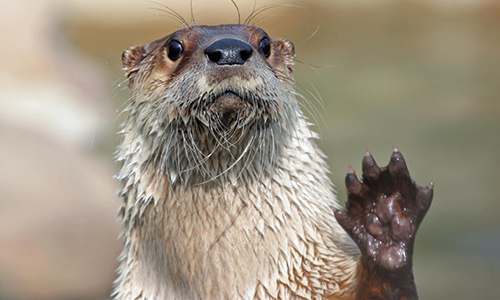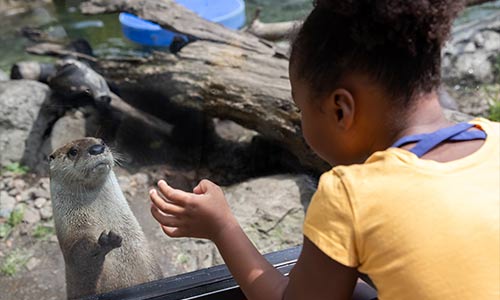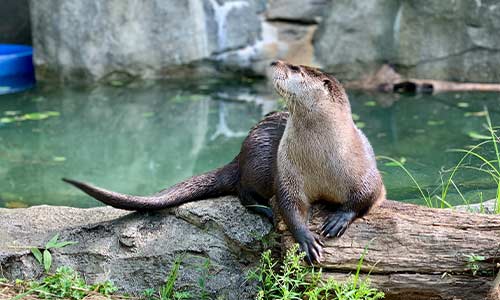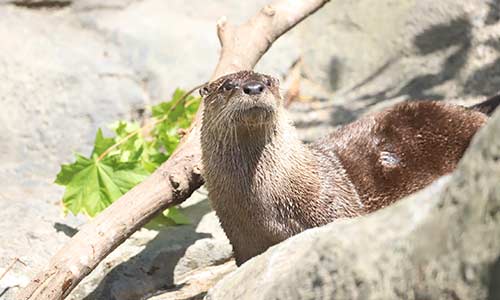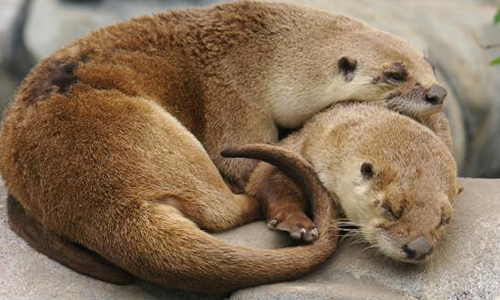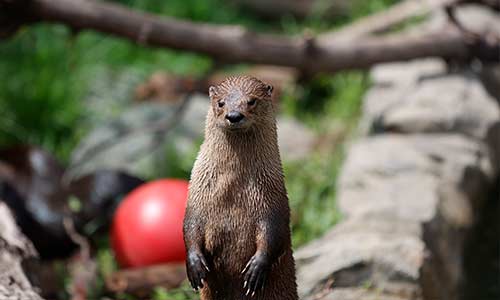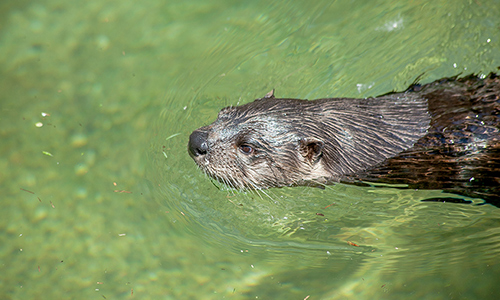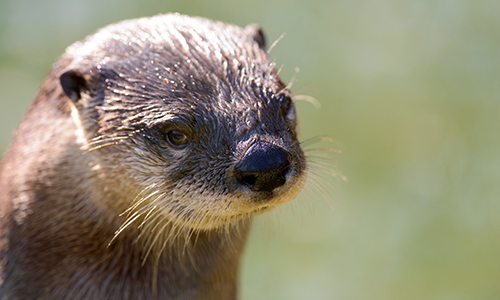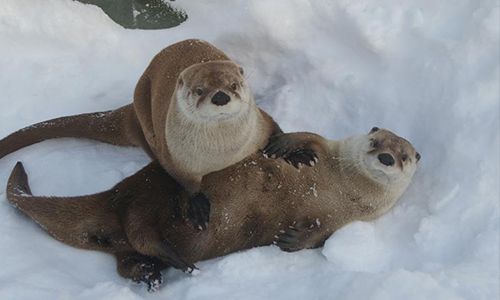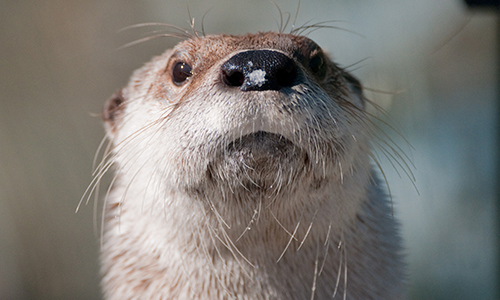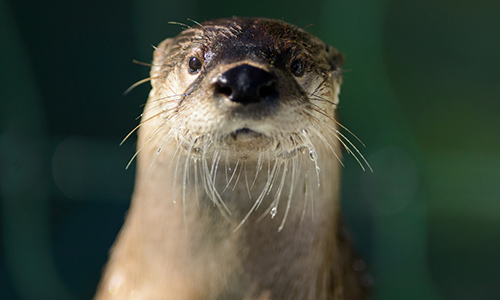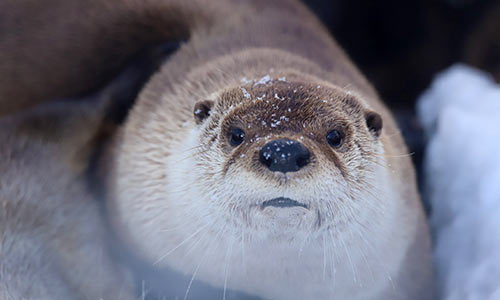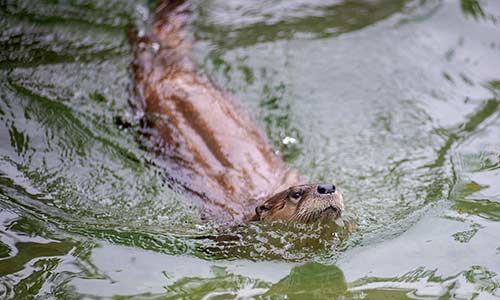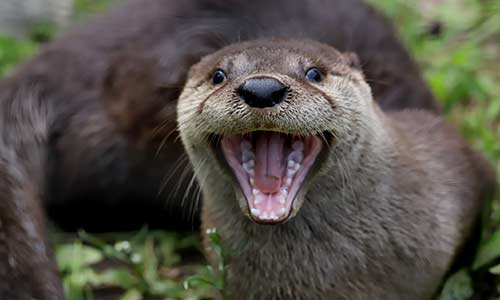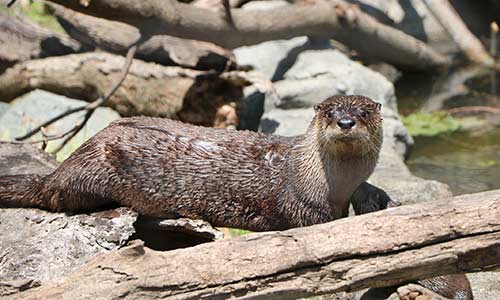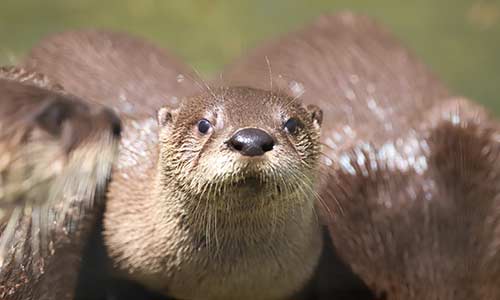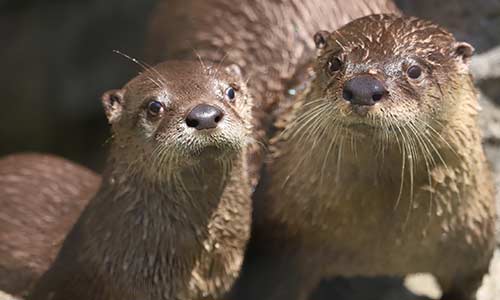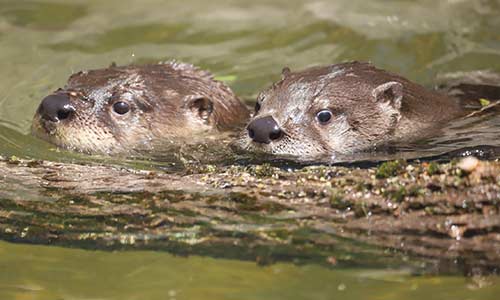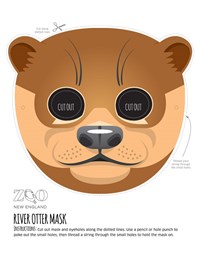North American River Otter
Lontra canadensis
Tune into our live cam!
Cam hours: Daily, 9am - 4:45pm
You can control the cam by clicking the ![]() button in the lower right corner of the viewing window.
button in the lower right corner of the viewing window.
About the North American River Otter

Geographic Range:
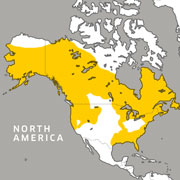
Class: Mammalia
Order: Carnivora
Family: Mustelidae
Genus: Lontra
Species: canadensis
Otters are champion swimmers. As they glide through the water, they hold their forelegs back against their cylindrical bodies and use their tail as a rudder. Thick coats and a layer of fat waterproof and insulate the otter from cold water and temperatures. They're even able to close off their ears and nostrils while diving, making them watertight.
River Otter Facts
Appearance:
River otters are generally brown in appearance and have thick guard hairs covering their waterproof undercoat. Their underside is light brown or silvery grey. The neck nearly equals the size of the head, and long whiskers cover the snout. Otters have short, powerful legs and webbed feet with intractable claws. The tail is thick, tapered and flattened on the underside.
The otter’s cylindrical body is streamlined for efficient swimming. They hold their forelegs back against their bodies and use their tail as a rudder. The otter’s webbed feet add to its speed. Since the otter’s eyes are located on top of its head, it’s able to see above the water while submerged. Otters are able to close off their ears and nostrils while diving, making them watertight. Their sensitive whiskers help them detect prey even in murky water. Their sharp claws and dexterity aid in digging and retrieving prey.
The otter’s thick undercoats and layer of fat provide insulation against frigid water and cold air temperatures while their thick guard hairs (reported by a Canadian scientist to number 40,000 per square inch) form a waterproof outer layer to protect the otter's undercoat.
Size:
Weight: 10 to 30 pounds
Length: 3 to 4.5 feet; tail is 1/3 of entire length
Diet:
Opportunistic carnivores (meaning they eat whenever the opportunity presents itself), otters feed primarily on fresh-water fish. They’ll also eat crayfish, frogs, invertebrates, snakes, birds, carrion, and occasionally small mammals.
Reproduction:
The otter’s breeding season is March through April. The gestation period is 9 to 12 months; like other members of the weasel family, implantation of the otter’s embryo can be delayed. Typically, there are two or three kits born in dens between January and May. They're blind and toothless but fully furred at birth. Their eyes open at 5 weeks of age; the kits are able to forage with their mother by 75 days. They're weaned at 4 to 5 months and stay with their mother though the following winter, but may leave as early as the fall. Otters reach sexual maturity at 2 years, but males may not be able to successfully breed until 5 to 7 years of age.
Behavior:
Otters are mainly solitary but may hunt with offspring or join other females during the breeding season. They tend to avoid areas that are scent-marked by others, so contact and territorial conflict is minimal. Generally, otters are most active from dusk until dawn, but during the winter months they're more active during the day.
As water-dwellers, otters are excellent swimmers and divers, capable of speeds of 7 miles per hour. They hunt by diving after and chasing fish into shallow coves. Some prey is taken by digging into the substrates of ponds and streams. Otters can be playful and at times have been seen sliding down riverbanks, tumbling in the snow or sliding on ice. They’re extremely curious and will explore and scent-mark a wide territory from 50 to 100 miles.
Habitat/Range:
Historically, otters were found over most of North America, except the dry Southwest U.S. and treeless arctic. Today, otters live along the Atlantic and Gulf of Mexico coasts, the Pacific Northwest, the Great Lakes, and most of Canada and Alaska.
Otters mainly inhabit fresh water rivers, streams, inlets, lakes and coastal marshes. They’ll sometimes venture into marine coves. They prefer deep bodies of water and avoid polluted water.
Life Expectancy:
Average 12 years
Predators:
In the water, river otters are preyed on by alligators, American crocodiles and killer whales. The list of predators increases when on land, leaving them more vulnerable to bobcats, cougars, coyotes, dogs and wolves.
Conservation:
The International Union for Conservation of Nature (IUCN) lists the river otter as least concern because its population is not currently declining fast enough to be threatened. In the past, river otters declined due to illegal trapping, water pollution and poor habitat quality. Recent efforts to improve water quality and regulate hunting have restored wild populations.
Fun Facts:
- The river otter is non-territorial, but it still marks around its home range using feces and urine as a form of communication.
- River otters can stay under water for as long as 8 minutes.
- Otters' playful behaviors like mud/snow sliding, burrowing through snow, and waterplay help strengthen social bonds and allow them to practice hunting and scent-marking.
Committed to Conservation
Zoo New England participates in the North American river otter Species Survival Plan. By sharing research and knowledge, participating institutions work together to establish guidelines that best ensure the health of captive populations, and with success, the survival of endangered species.
You Can Find This Animal in the Treetops and Riverbeds
Zoodopt an Otter!
Zoodopts support the care and feeding of our animals, and with each purchase, we'll bring a little of the Zoo to you! Zoodopt today!
Kids' Corner
You "otter" check out our arts-and-crafts and learn more about Stone Zoo's otters in our Kids' Corner!
W-otterways
Otters are indicator species for the health of the bodies of water where they live. They avoid contaminated areas, so when you spot otters, it's likely you're looking at a healthy and clean body of water! You can help otters by reducing your pollution and keeping our "wotterways" clean.
You might also like
At Franklin Park Zoo:
At Stone Zoo:

